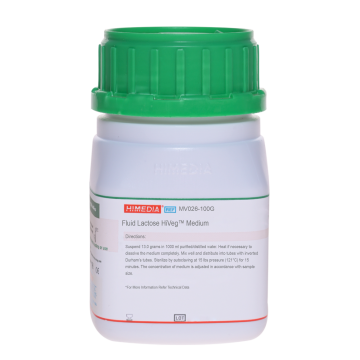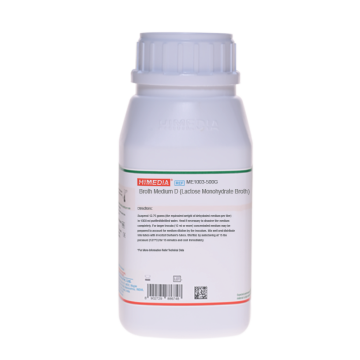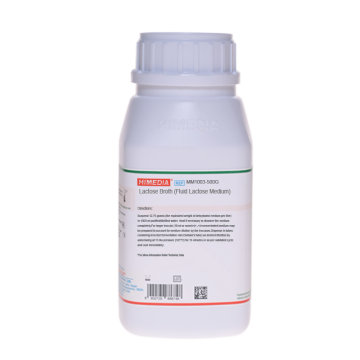 Your enquiry has been submitted
Your enquiry has been submitted
Fluid Lactose Medium
Non selective media for Enrichment and Propagation#CC293D
Intended use
Recommended as a pre enrichment medium for detection of coliform bacteria in water, dairy products and food samples.
Composition
| Ingredients | g/L |
|---|---|
| Gelatin peptone | 5.000 |
| HM peptone B# | 3.000 |
| Lactose | 5.000 |
Final pH (at 25°C): 6.9±0.2
**Formula adjusted, standardized to suit performance parameters # - Equivalent to Beef extract
Directions
Suspend 13.0 grams in 1000 ml purified/ distilled water. Heat if necessary to dissolve the medium completely. Mix well and distribute into tubes with inverted Durhams tubes. Sterilize by autoclaving at 15 lbs pressure (121°C) for 15 minutes. The concentration of medium is adjusted in accordance with sample.
Principle And Interpretation
Coliforms are rod shaped gram-negative organisms that ferment lactose with the production of acid and gas. They are regarded as bacterial indicators of sanitary quality of foods and water. Salmonella is a rod shaped gram-negative enterobacteria commonly implicated in foodborne illness. These bacteria are present in low numbers in food and other products and also may be in a stressed condition. Before subjecting them to selective enrichment, for maximum recovery a pre-enrichment is necessary. Also, the presence of non-coliform bacteria and substances indigenous to the sample may interfere with the growth and recovery of coliforms. Therefore pre-enrichment in a non-selective medium facilitates detection of sublethally injured cells. Fluid Lactose Medium is a pre-enrichment medium, recommended by APHA, for the detection of coliform bacteria in water, dairy products and food samples (1,2,3). When competing lactose utilizing bacteria are present in the test sample, a resulting drop in pH generates a bacteriostatic effect on the competing microflora. It is also used in the performance of test for Salmonella species and Escherichia coli
HM Peptone B and gelatin peptone provide essential nutrients for bacterial metabolism. Lactose is the sole source of fermentable carbohydrate. Growth with gas formation is a presumptive test for coliforms. Whenever there is larger inoculum microbial limit multiple strength lactose broth is used.
Type of specimen
Food and dairy samples; Water samples
Specimen Collection and Handling:
- For food and dairy samples, follow appropriate techniques for sample collection and processing as per guidelines (2,3).
- For water samples, follow appropriate techniques for sample collection, processing as per guidelines and local standards.(1)
- After use, contaminated materials must be sterilized by autoclaving before discarding.
Warning and Precautions :
Read the label before opening the container. Wear protective gloves/protective clothing/eye protection/ face protection. Follow good microbiological lab practices while handling specimens and culture. Standard precautions as per established guidelines should be followed while handling specimens. Safety guidelines may be referred in individual safety data sheets.
Limitations :
- Further biochemical tests must be carried out for confirmation.
Performance and Evaluation
Performance of the medium is expected when used as per the direction on the label within the expiry period when stored at recommended temperature.
Quality Control
Appearance: Cream to yellow homogeneous free flowing powder
Colour and Clarity of prepared medium: Light amber coloured, clear solution without any precipitate
Reaction: Reaction of 1.3% w/v aqueous solution at 25°C. pH: 6.9±0.2
pH: 6.70-7.10
Cultural Response
Cultural characteristics observed after an incubation at 35 - 37°C for 18-48 hours.
| Organism | Inoculum (CFU) | Growth | Gas |
|---|---|---|---|
| # Klebsiella aerogenes ATCC 13048 (00175*) | 50-100 | good to luxuriant | positive reaction |
| Escherichia coli ATCC 25922 (00013*) | 50-100 | good to luxuriant | positive reaction |
| Enterococcus faecalis ATCC 29212 (00087*) | 50-100 | good to luxuriant | negative reaction |
| Pseudomonas aeruginosa ATCC 27853 (00025*) | 50-100 | good to luxuriant | negative reaction |
Key: * Corresponding WDCM numbers (#) Formerly known as Enterobacter aerogenes
Storage and Shelf Life
Store between 10-30°C in a tightly closed container and the prepared medium at 15-30°C. Use before expiry date on the label. On opening, product should be properly stored dry, after tightly capping the bottle in order to prevent lump formation due to the hygroscopic nature of the product. Improper storage of the product may lead to lump formation. Store in dry ventilated area protected from extremes of temperature and sources of ignition Seal the container tightly after use. Product performance is best if used within stated expiry period.
Disposal
User must ensure safe disposal by autoclaving and/or incineration of used or unusable preparations of this product. Follow established laboratory procedures in disposing of infectious materials and material that comes into contact with sample must be decontaminated and disposed of in accordance with current laboratory techniques (4,5).
Reference
- Lipps WC, Braun-Howland EB, Baxter TE, eds. Standard methods for the Examination of Water and Wastewater, 24th ed. Washington DC:APHA Press; 2023.
- Marshall R. T., (Ed.), 1992, Standard Methods for the Examination of Dairy Products, 16th Ed., APHA, N.Y.
- Salfinger Y., and Tortorello M.L., 2015, Compendium of Methods for the Microbiological Examination of Foods, 5th Ed., American Public Health Association, Washington, D.C.
- Isenberg, H.D. Clinical Microbiology Procedures Handbook. 2nd Edition.
- Jorgensen, J.H., Pfaller, M.A., Carroll, K.C., Funke, G., Landry, M.L., Richter, S.S and Warnock., D.W. (2015) Manual of Clinical Microbiology, 11th Edition. Vol. 1.
| Product Name | Fluid Lactose Medium |
|---|---|
| SKU | M026 |
| Product Type | Regular |
| Physical Form | Powder |
| Origin | Animal |
| Packaging type | HDPE |
| References | 1. Greenberg A. E., Clesceri L. S. and Eaton A. D., (Eds.), 1998, Standard Methods for the Examination of Water and WasteWater, 20th Ed., APHA, N.Y. 2.Marshall R. T., (Ed.), 1992, Standard Methods for the Examination of Dairy Products, 16th Ed., APHA, N.Y. 3.Downes F. P. and Ito K. (Ed.). 2001, Compendium of Methods for the Microbiological Examination of Foods, 4th Ed.,American Public Health Association, Washington, D.C. |
| Customized Product Available | No |








